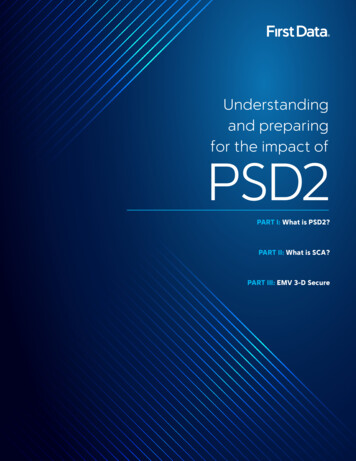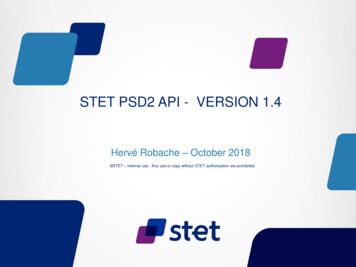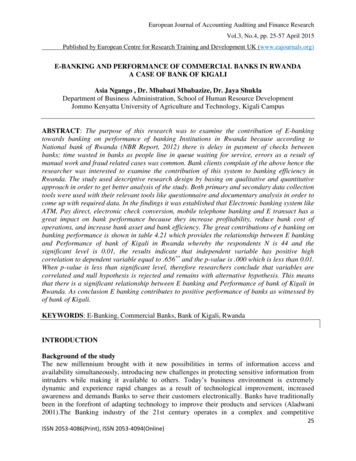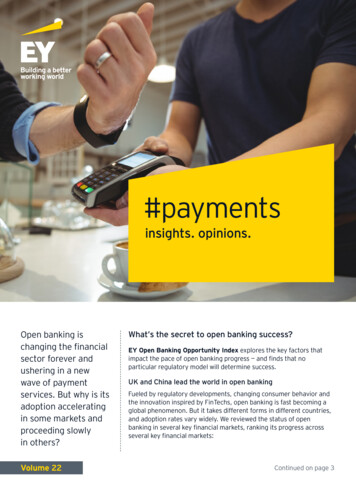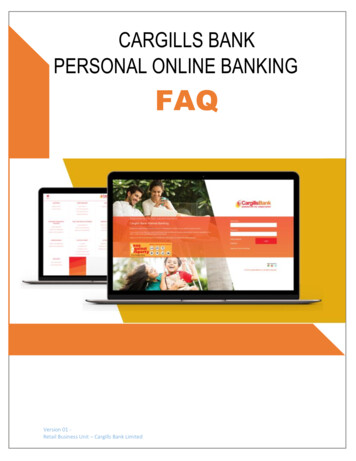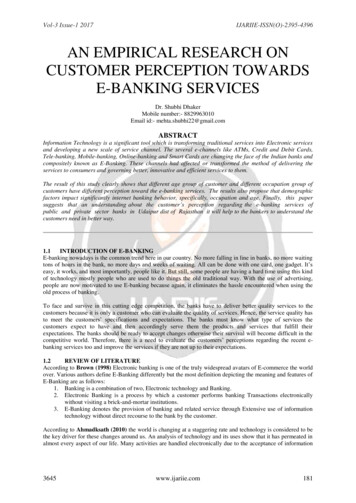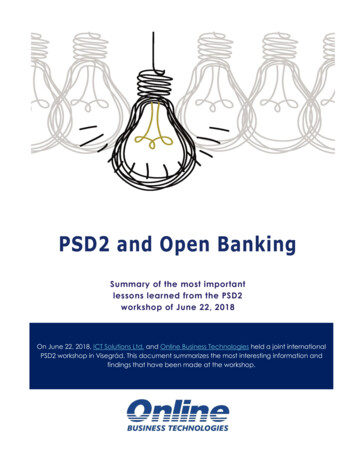
Transcription
PSD2 and Open BankingSummary of the most importantlessons learned from the PSD2workshop of June 22, 2018On June 22, 2018, ICT Solutions Ltd. and Online Business Technologies held a joint internationalPSD2 workshop in Visegrád. This document summarizes the most interesting information andfindings that have been made at the workshop.
IntroductionThe PSD2 and the so-called open banking is one of the most frequently discussed topics in thebanking conferences today.This is no coincidence: the evolution of information technology has enabled new businessmodels to evolve in a number of industries, changed consumer habits, and these changespenetrated the financial services market through FinTech and BigTech companies. PSD2facilitates this process from the regulatory side, since it allows FinTech companies to accessbanking databases to help promote the spread of financial innovation. Open banking is acollaborative model in line with the above changes, whereby banks try to provide higherquality and more versatile services to their customers by involving FinTech companies.The aim of the PSD2 workshop of 22 June 2018 was to share deeper professional informationrelated to PSD2 and Open Banking and to provide an opportunity to discuss these information.The event gave a 360-degree picture of PSD2 and Open Banking, addressing both PSD2'sregulatory issues, business opportunities, as well as IT implementation. Gijs Boudewijn,Chairman of the Legal Support Section of the European Payments Council, presented thelatest regulatory news, Peter Gába, the leader of the Erste Group's Open Banking Initiative,gave a review of the use of open banking for business purposes, while from our companyJózsef Németh presented the IT challenges of compliance with PSD2. The lectures werefollowed by a panel discussion in which John Basquill, a journalist at Payments Compliancemoderated the professional dialogue between the audience and the performers.Prior to the event, we have compiled a detailed list of the PSD2 issues most important for thebanking sector. The Gárdos Mosonyi Tomori Law Office was also involved in the preliminaryprocessing of these topics.In this document, we review what information and findings we have found to be mostinteresting at the event. We hope the summary will be useful and will meet you at our nextevents!Budapest, 2018.06.28.The Team of Online Business Technologies
Information, findingsAPI standardsThe incorporation of the PSD2 Directive in the EU memberstates is delayed, so at the time of the workshop, the PSD2regulations have not yet been included in all Member State'snational legislation. This delay will cause problems with the socalled passporting, when a payment service provider,disposing of a service license valid in a given country,attempts to host that license in another member state (seeArticle 14 of the PSD2 Directive).PDS2 API standardsThe EU reviews large PSD2APIs for compliance with theRTS SCA, but despitestandardization, we expectdifferent APIs per bank.In early 2018, the European Commission and the European Accordingly, technicalCentral Bank initiated the establishment of an API Evaluation service providersGroup, aimed at providing – through the analysis of the five safeguarding anbiggest API standards (Open Banking UK, Berlin Group - interconnection betweenNextGenPSD2, STET, the Slovak National API, the Polish PSD2 APIs, will have aNational API) - a general guidance concerning the prominent role.compliance to the regulations of the Regulatory TechnicalStandard of Strong Customer Authentication and securecommunication (RTS SCA) no. 2018/389, issued to PSD2. Memos of the group meetings areavailable on the European Payments Council website (www.europeanpaymentscouncil.eu).If we look at the European panorama, the NextGenPSD2 of the Berlin Group, is growing inimportance: Germany, Italy and the Netherlands have moved towards this standard, and theFrench STET standard has also been harmonized with NextGenPSD2.Concerning the listed PSD2 API standards, it is worth mentioning that these are so called APIInitiatives, which means that the standards do not describe a specific technicalimplementation, but define technical components that can be used to create a PSD2 API. Thelogical consequence of this is that even two NextGenPSD2 interfaces will not be technicallyidentical, so all PSD2 APIs - even those of the same standard - will be somewhat different!Technical communications providersAs a consequence of the foregoing paragraphs, the importance of companies that provide agateway between different PSD2 APIs is growing. The core of these companies' services is thatthey provide a single connecting interface to Third Party Providers (TPPs) sending PSD2transactions/information requests, because all further interfacing to the banks’ PSD2 APIs willbe managed by these service providers, constructing a star communications connectionbetween TPPs and the banks. The question arises whether these technical service providersshould qualify themselves as payment service providers (TPPs)? According to our preliminary1
analysis, this is not necessary. The technical service provider and the TPP initiating themessages must enter into a contract which, according to which the technical service provideris providing, on behalf of the sending TPP, so called outsourced activities for the TPP.Accordingly, for third parties, the sending TPP is responsible for the activities of the technicalservice provider, and their responsibilities must be settled in a contract concluded betweenthem.Strong customer authenticationStrong customerauthenticationConforming the EBA's June13, 2018 opinion, a strongcustomer authenticationbased solely on redirect islegitimate and it is notmandatory to use otherauthentication methodsbased on the transfer ofcustomer authenticationdata to TPPs.Strong customer authentication is one of the cornerstones ofPSD2 services. The publication of the final version of RTS SCAon 27 November 2017 raised the question of whether Article32 (3) of RTS SCA prohibited the use of authenticationmethods based on redirection not requiring the release ofpersonal credentials (such as OAuth and OpenID Connectstandards)? A further question was whether or not it would bemandatory to use the so called embedded authentication,based on the transfer of customers’ personal credentials? Theopinion of the European Banking Authority (EBA) of 13 June2018 clarified the situation: the redirection itself does notconstitute an obstacle, if it is not created in a preventivemanner, and it is not mandatory to use other authenticationprocedures, other than the redirect authentication.Many people think that applying PSD2's strong clientauthentication rules is only mandatory when accessing TPPs via the API. That's a mistake. AsArticle 97 of the PSD2 provides for strong client authentication when accessing customeraccounts online, therefore, strong customer authentication rules are mandatory for theNetBank and MobilBank solutions directly used by the customer, too.Exceptions to strong customer authenticationThe RTS SCA provides banks with the opportunity to improve the customer experience bymaking omission of strong customer authentication, in case of some so called low-riskoperations. The scope of these operations is listed in chapter III of the RTS SCA.The use of exceptions is optional for banks and the use of exceptions results in a major changein liability relationships, in the case of payment transactions, since if the payer's paymentservice provider does not apply strong customer authentication, Article 74 (2) of the PSD2Directive states that the payer is not liable for any loss unless he has acted fraudulently.The above procedure and consequences are commonly known by banks and we oftenencounter the view that the use of strong customer authentication will be decided individually2
by the bank in its own jurisdiction, without prior notification to customers. Although this isbasically true, we believe that exceptions should be reported to customers. This is due to thefact that the use of strong customer authentication entails a change of responsibilities, ofwhich customers are to be informed in advance, so we believe that the principles ofexception management should be published in advance in bank announcements.With regard to the exceptions, it is worth mentioning that the exceptions include an area oftenoverlooked. Article 17 of the RTS SCA allows the use of exceptions for secure businessprocesses when the competent authorities are satisfied that the procedures used allow thesame level of security as the level of security defined in the PSD2 Directive. At this time, there isno EU resolution on how and on what conditions this exemption can be obtained, so it isadvisable to contact the competent local authorities concerning this issue!What is to be considered an account with onlineaccess?PSD2 requires access to online accounts via the PSD2 API(see Articles 65, 66 and 67 of the PSD2 Directive). Everyoneagrees that accounts available through customers via thenetbank, mobile banking channel should be included in thiscircle. But what about the so-called home banking systemsused in companies, or ad absurdum the ATMs softwarethrough which the client can remotely access his accounts?There is no uniform approach to this, but for example. theBritish legislator applied the following approach toimplementing PSD2: "Any invoice available to the customerthrough the Internet is to be considered as available online,regardless of the technical solution utilized.”Transactions availablethrough APIIn its opinion published onJune 13, 2018, the EBAclarified that any paymenttransaction initiated by acustomer (such as ible via APIs, not onlythe e-commerce relatedone-time payments.The range of payment transactions available through APIsFor PSD2 projects, there is a serious question of what payment transactions should be made viathe PSD2 APIs. In this regard, it was previously the position of European banks that paragraphs27 and 95 of the preamble to PSD2 clearly refer to e-commerce support, so it is sufficient forone-time payment transactions related to e-commerce to be accessed through the PSD2APIs. The EBA's aforementioned opinion disagreed on this because it clarified that based onthe definitions of the PSD2 directive, all payment transactions (e.g. group transfers, regulartransfers, value-dated transfers) should be made available through the PSD2 APIs.3
Fallback solutionsFallback solutionsThe use of screen scrapingplus is a risky procedure forbanks, even as a fallbackmeasure. The solution is tocreate good APIsconforming the bigstandards, and to obtainexemptions from localauthorities from theutilization of screen scrapingplus as a backup solution.Article 31 of the RTS SCA offers two options for solving TPPaccess. One of the options is the creation of a target specificdedicated interface, which is a technical channel separatedfrom other system-access points crated for the PDS2 services.The other option is that the bank offers the same accesschannel for TPPs to access PSD2 services, which it uses as thechannel for authenticating and communicating with thebank's customers (e.g. NetBank, MobilBank). If the dedicatedinterfaces do not work, then the netbank channel should bemade available for the TPPs as a fallback solution – in case ofabsence of exemptions from local authorities.If the TPPs use this latter channel to access the PSD2 services,the so-called screen scraping technology, more specifically itsTPP authentication version, the screen scraping plus is used fornetbanking screen functions and for data extraction.The vast majority of banks are thinking of developing the technically more safer dedicatedinterfaces, and generally believe that the they have nothing to do with the fallback procedurereferred to in the previous paragraph, since in these cases the TPPs automatically „scrape” thenetbank, and – as per point 5 of paragraph 33 of the RTS SCA - all responsibility is borne by theTPP. Unfortunately, both points are wrong.When using screen scraping plus, TPPs need to be authenticated, so banks need to modifytheir netbank when opening this channel as a fallback procedure. And although Article 33 ofRTS SCA actually imposes obligations on TPPs, but the core responsibility toward customersremains unchanged, so it is in the bank's primary interest that TPP access is strictly controlled inthese cases, too.The solution is simple. Good PSD2 APIs should be made and local authorities should beconvinced to grant exemption to the bank from utilizing screen scraping plus (see Point 6,Article 33 of the RTS SCA). If a bank uses one of the above-mentioned big standards, thisexemption is expected to be easily obtainable.4
Business Opportunity - Banks in TPP RoleBanks as TPPsOne of the businessopportunities for PSD2 iswhen banks themselveslaunch TPP services.Banks do not need to obtainany additional license forthis.Banks are serious about the business utilization of PSD2 APIs.One logical way is that banks themselves provide TPPservices. These may be "classic" FinTech services (e.g.personal budgeting), but they can also use informationrecovery through the PSD2 API in traditional bankingprocesses, like for example customer's account statementsare queried - with the client's consent - through an API duringcredit sales. Regardless of the nature of the TPP service thebanks are willing to launch, they may provide online credittransfer or bill information services at their own discretion, sothey do not need any extra license.Business Opportunity - can data collected for other purposes be used forPSD2 services?A common business question about the data gathered with the PSD2 is whether theinformation thus obtained can be used by the bank for other purposes? Do you need thecustomer's consent for such use? If so, how much concrete support will be required fromcustomers? Anyhow, is it possible any data transfer/data utilization without the customer'sconsent after the entry into force of the GDPR?The PSD2 Directive and the RTS SCA are clear on this issue: in the absence of a customer'sconsent, data should not be used to provide other services. If the client agrees to use his data,it is already possible to use the data, but according to the GDPR, the request for consent mustbe sufficiently specific, ie the bank should specify the service to be provided to the client andhow data will be used. Consequently, a general consent request is not possible, like forexample, We would like to use your personal information to develop new products. It shouldbe noted, however, that data sets can be utilized for research-development purposes,following the anonymization of the datasets (the blanketing of personal data).With the help of a customer-authorization, it is also possible for several banks to build acommon database, but when this activity is continued, attention should be paid to therequirement of Article 26 of the GDPR and the participating banks must conclude a datamanagement contract in which they detail their duties and responsibilities.In connection with this, it is worth pointing out that the entry into force of the GDPR does notmean that, from now on, the client's consent is required for all data transmission, dataprocessing. This is not the case. If, for example, the disclosure of data is made mandatory bylaw, then the communication may also be made without the consent of the customer.5
Business Opportunity - Open BankingOpen Banking means that a particular bank, in addition tothe requirements of PSD2, also offers a wide range of servicesthrough APIs, or the bank itself also accesses a wide range ofservices from other providers through APIs.Open Banking enables the creation of service ecosystems. Inthese service ecosystems, individual providers (e.g. insurers,traders) are connected on the level of IT systems, through theAPIs, and are able to reach each other's services (e.g.initiating the sale of a given product). Through APIconnectivity, it is possible to cover entire service value chains,as in today's large companies, the combination of individualsystems can cover entire corporate processes. However,these ecosystems are not rigid structures, since a givenprovider can use the API of an other provider in a way thathas not been seen before, to provide a previously unseenservice.Open BankingOpen banking enables thecreation of serviceecosystems. The members ofthe ecosystem areconnected on the IT systemlevel, through APIs, so theycan cover entire servicevalue chains and are ableto sell each other's services.The business rationality of the ecosystem is that the services of an organization that opens upAPIs can be accessed by a wide range of companies, and the related companies can usethe services they have achieved to provide other services, so the bank can "sell" its servicesmuch more widely than it would be possible based solely on its own resources.6
Our solution for PSD2 and Open Banking - DigiTieWe have an IT solution, which helps to meet the challenges of PSD2 and Open Banking, that isDigiTie. DigiTie PSD2 enables banks to be compliant with PSD2.DigiTie for PSD2 serves as a front-layer for banks to manage the requests of TPPs (Third PartyProviders) from PSUs (Payment Service Users) 24/7/365 and to transfer the requests to corebanking systems of ASPSPs (Account Servicing Payment Service Providers). It is developed tobe compliant with any PSD2 standard (OpenBankingUK, NextGenPSD2, STET). The solution usesstate-of-the-art technologies like RESTful interfaces, TLS 1.2 for secure connections, OAuth 2.0and OpenID Connect 1.0 for authentication and authorization, X.509 for certificates. The PSD2solution provides different options for SCA, such as the classical combination of staticpasswords and dynamic passwords sent in SMS, or highly advanced methods like thecombination of using fingerprints and mobile app-based certification. The mobile app for SCAis available on iOS and Android platforms. It is also possible to rely on the existing SCA methodsof banks.Upon request we can connect DigiTie for PSD2 to core banking systems using either existingbank e-channel (e.g. Internet Banking) interfaces or a new, customized interface. In the caseof existing interfaces only minor development is required from the bank.The solution is able to handle exemptions from SCA, like low-value transactions, contactlesspayments etc. In order to ensure secure operation, it also includes limit handling, and as partof the Fraud component offline confirmation etc.DigiTie for PSD2 helps you to be compliant with PSD2 regulations and gives you the opportunityto extend the solution with further services later (see on the next page).7
While DigiTie for PSD2 opens services necessary to be compliant with PSD2, DigiTie for OpenBanking can open up additional services to join FinTech ecosystems. The options are endless inthis area, which might include 24/7 loan disbursement based on applications submitted byFinTechs, or creating deposit accounts based on the request of PFM (Personal FinanceManagement) solutions. DigiTie for Open Banking includes all the functions of DigiTie for PSD2and provides additional features to help the cooperation with FinTechs (see the picturebelow).These features include custom tailored Open APIs for FinTechs under RESTFUL or othertechnologies (e.g. SOA web service). While DigiTie for PSD2 opens only a few payment servicesfree of charge, DigiTie for Open Banking makes other banking services (e.g. loans, deposits)available under agreed business terms.In order to support these services 24/7, DigiTie for Open Banking provides core bankingfunctionality for time periods when main systems are down, serving as a shadow core system.These new services will be available for agreed fees that can be managed by the Fees andcommissions module. New channels might require the selling of new products. This is the pointwhere the Sales front and the Product Development modules can help.Online Business TechnologiesH-1032 Budapest, Vályog street 3. 36-1-437-0700 https://www.online.hu/contact8
PSD2 and Open Banking Summary of the most important lessons learned from the PSD2 workshop of June 22, 2018 On June 22, 2018, ICT Solutions Ltd. and Online Business Technologies held a joint international PSD2 workshop in Visegrád. This document summarizes the most interesting information and findings that have been made at the workshop.
